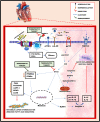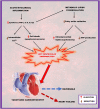The Synergy of ADAM17-Induced Myocardial Inflammation and Metabolic Lipids Dysregulation During Acute Stress: New Pathophysiologic Insights Into Takotsubo Cardiomyopathy
- PMID: 34150874
- PMCID: PMC8212952
- DOI: 10.3389/fcvm.2021.696413
The Synergy of ADAM17-Induced Myocardial Inflammation and Metabolic Lipids Dysregulation During Acute Stress: New Pathophysiologic Insights Into Takotsubo Cardiomyopathy
Abstract
Due to its reversible nature, Takotsubo cardiomyopathy (TTC) is considered an intriguing and fascinating cardiovascular disease characterized by a transient wall motion abnormality of the left ventricle, affecting more than one coronary artery territory, often in a circumferential apical distribution. Takotsubo cardiomyopathy was discovered by a Japanese cardiovascular expert and classified as acquired primary cardiomyopathy by the American Heart Association (AHA) in 1990 and 2006, respectively. Regardless of the extensive research efforts, its pathophysiology is still unclear; therefore, there are no well-established guidelines specifically for treating and managing TTC patients. Increasing evidence suggests that sympatho-adrenergic stimulation is strongly associated with the pathogenesis of this disease. Under acute stressful conditions, the hyperstimulation of beta-adrenergic receptors (β-ARs) resulting from excessive release of catecholamines induces intracellular kinases capable of phosphorylating and activating "A Disintegrin and Metalloprotease 17" (ADAM17), a type-I transmembrane protease that plays a central role in acute myocardial inflammation and metabolic lipids dysregulation which are the main hallmarks of TTC. However, our understanding of this is limited; hence this concise review provides a comprehensive insight into the key role of ADAM17 in acute myocardial inflammation and metabolic lipids dysregulation during acute stress. Also, how the synergy of ADAM17-induced acute inflammation and lipids dysregulation causes TTC is explained. Finally, potential therapeutic targets for TTC are also discussed.
Keywords: ADAM17; acute myocardial inflammation; acute stress; metabolic lipids dysregulation; pathophysiology; takotsubo cardiomyopathy; therapeutic targets.
Copyright © 2021 Adu-Amankwaah, Adzika, Adekunle, Ndzie Noah, Mprah, Bushi, Akhter, Xu, Huang, Chatambarara and Sun.
Conflict of interest statement
The authors declare that the research was conducted in the absence of any commercial or financial relationships that could be construed as a potential conflict of interest.
Figures


References
-
- Sato TH, Uchida T, Dote K, Ishihara M. Tako-tsubo-like left ventricular dysfunction due to multivessel coronary spasm, In: Kodama K, Haze K, Hori M. editors. Clinical Aspect of Myocardial Injury: From Ischemia to Heart Failure. Tokyo: Kagakuhyoronsha Publishing Co. (1990). p. 56–64.
Publication types
LinkOut - more resources
Full Text Sources
Miscellaneous

